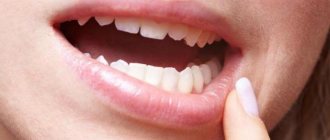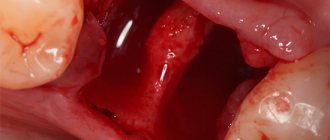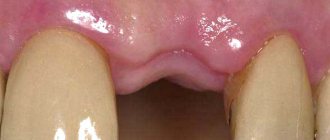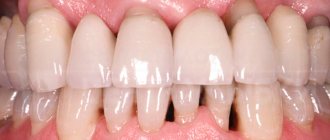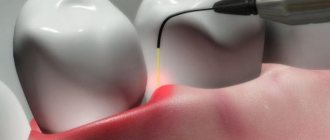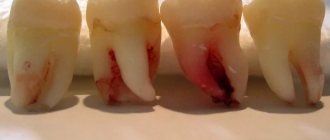After the removal of a wisdom tooth, when the “freezing” has already gone away, patients are bothered by pain. This is a normal reaction of the body to surgery. The pain gradually subsides and disappears completely within 5-7 days.
But not everyone finds saying goodbye to the G8s quick and easy. Increasing pain, swelling, hematomas and bleeding are a sure sign of complications, which, alas, cannot be cured in a week. How to distinguish pathology from the norm and prevent complications - read on.
Why does it hurt
The most obvious reason is the body’s natural physiological response to surgical trauma. All third molars - wisdom teeth - are large and have 2-5 roots. After their extraction, an open bleeding wound remains in the gum tissue and jawbone, caused by damage to the connections between the tissues.
The wound is filled with a blood clot - it is this that prevents infection from entering the hole and serves as the basis for the formation of granulation tissue - connective material that will fill the space formed after the removal of the 8. In the meantime, the hole remains injured, you may be worried about increased body temperature (within 37-37.5 degrees) and pain.
Normally, these symptoms gradually disappear within a week. But only with proper care.
Complications
All other causes of severe pain in the gums are associated with complications that arose during molar extraction or after surgery. These include:
- Alveolitis.
Infection of the socket of an avulsed tooth most often occurs due to the early loss of a blood clot or due to too weak immunity.
- Damage to capillaries when removing the figure eight.
Patients also complain of hematomas, swelling of the gums, and an increase in body temperature of more than 37.5 degrees.
- An allergic reaction to the anesthetic used for local anesthesia before surgery.
- Presence of root fragments in the hole.
If a tooth has not been completely removed, its remains provoke an inflammatory process in the socket, which also affects the gums.
It is easy to distinguish pathological pain from a reaction to surgery. They intensify progressively - they become stronger every day, radiating to the ENT organs, head, neck, chest.
This is often accompanied by bleeding from the wound, bruising, swelling and swelling. There are cases where, after a complex wisdom tooth extraction, swelling and bruising spread to the face, neck and chest and disappeared within six months.
How long does it hurt and how long does it take for gums to heal normally?
After a wisdom tooth has been removed, your gums will hurt for several days. As a rule, the pain is constant and does not depend on the influence of external stimuli. You can see what the gums look like after wisdom tooth removal in the photo.
If the extraction was carried out without preparing the wisdom tooth, the pain goes away already on the 3rd - 7th day of rehabilitation. Since gum healing takes longer, complete recovery is observed 14–21 days after surgery. Patients almost always claim that their gums itch after wisdom tooth removal. This itching is considered normal and indicates soft tissue regeneration.
Due to severe damage to soft tissue during the removal of a wisdom molar, the gums may hurt for up to 7 days. Due to the fact that the suture is removed 7-10 days after extraction, some patients complain of discomfort in the mouth throughout the entire time the hole in the gum is being closed. In this case, the mucous membrane takes a long time to overgrow with signs of inflammation.
To alleviate the postoperative condition, doctors prescribe painkillers and anti-inflammatory drugs. To prevent the wound from festering, it is recommended to use antiseptic rinses up to 2 times a day for preventive purposes.
Healing of the hole after simple removal
The process is individual, but with normal immunity the time frame varies between 3-7 days. If the procedure went without complications, after 3-4 days, granulation tissue - young connective tissue - is formed at the site of the blood clot. After 7 days, it spreads to almost the entire depth of the hole, with the exception of the very bottom.
After 2-3 weeks, the place of the root of the extracted tooth is completely occupied by connective tissue. And after 2-3 months from the moment of surgery, the hole in the jaw is “overgrown” with full-fledged bone tissue. By this moment, not a trace remains of the torn out “eight”.
These data are averaged. The sockets of the removed upper wisdom teeth heal quickly and without problems, but with the lower ones everything is not so smooth. The lower jaw has more nerve endings, and the lower molars have more “branched” roots. Therefore, the unpleasant sensations last longer.
Causes
A painful symptom after figure eight extraction is inevitable, but its strength depends on the following factors:
- The state of the remote third painter and his “neighbors”.
- Number of units removed.
- The presence of purulent formations in the oral cavity.
- Associated pathologies such as stomatitis, abscess, caries, periodontal disease and others.
- Degree of destruction.
- Chronic diseases of the body.
- Age category of the patient.
On this topic
- Wisdom teeth
First aid for inflammation of the gums near the wisdom tooth
- Maria Konstantinovna Tevs
- October 4, 2020
Most often, pain occurs due to injury to the soft and bone structures of the jaw. Because during the procedure the following happens:
- The ligaments are destroyed , and the blood vessels and nerve endings also suffer.
- When performing extraction, the doctor is forced to press on the walls of the hole; this occurs with the destruction of the nerve fibers located in this area.
- of infection expands somewhat and the temporary inflammatory process spreads to regional tissues - this is a normal reaction of the body to surgical intervention.
The following complications can cause pain:
- Post-traumatic alveolitis - that is, the infection penetrates into the socket when there is no blood clot, which should form after tooth extraction, otherwise called a “dry” socket. The resulting inflammatory reaction provokes severe throbbing pain, and purulent lesions are often observed. In the absence of qualified treatment, they can lead to an abscess or phlegmon.
- Fracture of the alveolar process - the doctor detects this consequence immediately after the procedure and prescribes the necessary treatment. Such damage can be caused by a medical error, but more often the cause is the anatomical features of the patient’s jaw or ankylosis. This complication occurs very rarely.
- A large wound after removal is often accompanied by swelling, which goes away after 2-3 days. Cold compresses are recommended.
Sometimes there is increased bleeding of the gums after extraction. In this case, the doctor will refer you for an examination to find out concomitant diseases. This is most often observed when the upper wisdom teeth are removed; this symptom is eliminated by tamponade and antihemorrhagic drugs.
What happens after complex removal
Complex removal refers to operations during which the gums are cut and/or the jawbone is drilled. Why such measures?
The fact is that impacted and dystopic lower “eights” grow too late and therefore do not have enough space in the dentition. Therefore, wisdom teeth take the wrong position and interfere with their fellow teeth.
To pull them out you have to:
- cut the gum (if the tooth is in the correct position, but has not erupted completely);
- or drill a figure eight piece by piece out of the jaw bone, if it remains right there without reaching the gum tissue.
If this is done on time and there is no inflammatory process in the oral cavity, healing will proceed approximately the same as in other cases. If you consult a doctor late, when purulent processes have made themselves felt, the wound will take longer to heal, at least for the duration of taking antibiotics.
Complex wisdom tooth removal
What to do after wisdom tooth removal, how to reduce pain
If your gums hurt after wisdom tooth removal, you should contact your dentist to prescribe treatment. To eliminate signs of inflammation, therapeutic rinses and applications with dental products are used. If the gums are very painful and the pain interferes with everyday life, painkillers are prescribed.
Medicines
When the gums become inflamed and severe pain appears, it is recommended to take painkillers. The dosage of medications is prescribed by the doctor based on the patient’s age and clinical picture of the disease. Effective painkillers for dental problems include:
- "Xefocam";
- "Dexalgin 25";
- "Nurofen";
- "Pentalgin";
- "Nise";
- "Ketanov."
It is important to remember that excessive use of painkillers is harmful to health. Taking medications more than 3-4 times a day is unacceptable.
Local anesthetics also improve the patient's condition and reduce pain in the mouth. The following are used as applications:
- spray "Lidocaine";
- gel "Cholisal";
- "Solcoseryl";
- "Metrogil Denta";
- "Kamistad".
Due to the composition of dental preparations, sprays and gels are used to destroy pathogens and so that gums begin to heal faster at home.
If the socket becomes infected, additional antibiotics are prescribed. Chemotherapy drugs destroy proteins and nucleic acids of inflammatory agents, preventing their further activity.
What to rinse after wisdom tooth removal
To eliminate lumps on the gums and reduce pain, use intraoral rinses. Often, stomatitis and gingivitis appear against the background of local inflammation. To prevent a secondary infection from occurring, it is recommended to rinse after tooth extraction using the following means:
- "Miramistin";
- "Chlorhexidine 0.05%";
- "Rotokan";
- "Stomatophyte".
Such drugs have anti-inflammatory, wound healing and antiseptic properties. It is recommended to rinse the wisdom tooth socket with chlorhexidine no more than 3 times a day due to the fact that the antiseptic components enter into a chemical bond with enamel minerals, contributing to the darkening of the teeth.
Traditional methods of treating pain in the gums
The effectiveness of traditional medicine has been known since ancient times. Natural components containing vitamins and other biologically active substances promote rapid gum regeneration and increase local immunity. The antiseptic properties of plant herbs stop the activity of bacteria and are not addictive.
Herbal medicine in dentistry involves the use of:
- chamomile flowers;
- calendula;
- oak bark;
- sage
To get quick results, all herbs are mixed together and infused in a water bath. Rinsing and intraoral baths are allowed with a warm herbal solution up to 5 times a day.
Soda-saline solution is used when pus forms in the hole. Sodium salts draw out unnecessary fluid from soft tissues, and the alkaline balance of the solution prevents further growth of bacteria. With this treatment, the pain subsides within the 3rd day.
Diet
When you give up hot and spicy foods, your gums heal much faster than with constant consumption of irritating foods. To enrich the body with all the necessary substances, it is necessary to add to the diet:
- lactic acid products;
- lean meat and fish;
- fresh vegetables and fruits;
- nuts and grains;
- fresh herbs.
If you have had your wisdom tooth hood removed
A wisdom tooth hood is the gum tissue that hangs over a partially erupted tooth. Residues of food fall under it, and bacteria “flock” to them, causing inflammation of the gums. If the hood is excised in time, before the inflammatory process begins, then the gums will heal in the same way as with a simple tooth extraction.
If purulent processes have already begun under the hood, the wound lasts longer, you will need to take antibiotics - Metronidazole in combination with Clindomycin or Lincomycin, or drugs based on Norfloxacin, Ciprofloxain, Ofloxacin.
Care after removal
To prevent pain, it is recommended:
- refrain from eating and drinking for the next three hours after surgery;
- do not eat too hot or hard foods for the first few days;
- avoid physical and emotional stress;
- do not smoke or drink alcohol for a week;
- postpone visiting the sauna and gym, or taking a hot bath.
To relieve pain, Nimesil, Tempalgin, Sedalgin, Ketanov, Solpadein, Baralgina or Nurofen are prescribed. It is allowed to apply cold compresses (ice) to the sore spot.
Under no circumstances should you stop hygiene procedures. To prevent bacteria from entering the wound after removing the figure eight, brush your teeth every time after eating, but carefully avoiding the injured gum. If the pain is too strong and you can’t brush your teeth, gently rinse your mouth with toothpaste diluted in water.
Give up bad habits within a week after removal
Symptoms of pain reaction after tooth extraction
Each person has a strictly individual concept of sensitivity to stimuli. Some people report unbearable pain and that the gums pulsate at the slightest touch, while others do not react even to fairly serious wounds. Some manifestations of pain after tooth extraction are considered normal and do not require special treatment.
Table. Classic signs and symptoms of pain after tooth extraction, not related to pathology:
| No. P/P | Manifestation of the problem | Possible solutions | Special Recommendations |
| 1. | Pain for 2-3 hours after removal. Unpleasant sensations gradually become aching and subside after 1-2 days. | Oral analgesics, non-steroidal anti-inflammatory drug (prescribed only by a doctor) | Do not endure pain if it does not go away, and especially if it grows over time. |
| 2. | Swelling of the gums after extraction. It is a temporary phenomenon, this is the body’s reaction to injury. | Application of cold compresses on the cheek side, painkillers. | Do not heat the surgical area. |
| 3. | Pain when opening the mouth, talking, eating. It may also be temporary. | Reduce the load on the masticatory muscles for 2 days, take analgesics. The problem does not appear after 5 days. | Avoid opening your mouth excessively. |
| 4. | Formation of hematoma on the cheek. Occurs due to excessive pressure on the tooth during surgery or due to traumatic removal. In addition, high blood pressure can also cause bruising in the soft tissue. | After removal, it is recommended to apply pressure to the surgical site. The problem usually disappears on its own after 7 days. | Requires supervision. If pain appears or the hematoma begins to grow, you should not self-medicate, but immediately contact the clinic. |
| 5. | Increased body temperature. It is possible to rise even to 39 degrees for 1-2 days. It is the resistance of the immune system, which is aimed at neutralizing the inflammatory process. | In case of critical indicators, it is recommended to take antipyretic drugs according to the regimen as indicated in the instructions. | Monitor your condition by systematically measuring your body temperature. |
The photo shows a tooth socket at the healing stage (week 2)
After the operation, the dentist usually always schedules a follow-up visit. It cannot be ignored, even in the absence of pathological symptoms. There are cases where complications were observed after quite a long time. These are the so-called sluggish inflammatory processes.
How to rinse
To protect the wound from infection, rinse your mouth with traditional or traditional medicine:
- Chlorhexidine;
- Stomatidine;
- Miramistin;
- Rivanol;
- Furacilin;
- decoctions of chamomile and calendula flowers, sage, oak bark.
You cannot start rinsing earlier than a day later. This is fraught with early loss of blood clot. Rinsing should also not be too active; it is better to do antiseptic baths - take the solution into your mouth, tilt your head briefly to the side of the sore spot, then spit.
Rinse solutions are prepared cool, since bacteria begin to actively multiply in a warm, humid environment. Alcohol-based products are not suitable for rinsing; they can cause gum burns.
Read how and what to rinse your mouth with for quick healing after tooth extraction.
What not to do
The sign gives detailed information about what not to do after tooth extraction.
Table 8. What not to do:
| What not to do? | Time frame after deletion | Why not? |
| First 24-48 hours | Severe swelling appears on the face. |
| 7 days | Active movements and increased pressure contribute to the opening of bleeding. |
| Up to 14 days | The seams may come apart. |
| All the time | The drug is a blood thinner. Bleeding may increase. Sometimes, while taking the medicine, a hematoma forms. |


